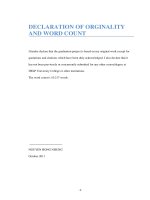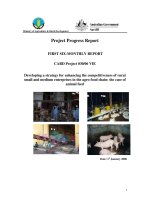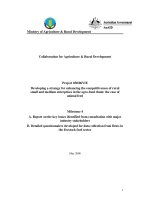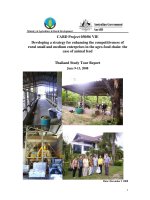Factors affecting application of accounting standards in Đà Nẵng based small and medium enterprises
Bạn đang xem bản rút gọn của tài liệu. Xem và tải ngay bản đầy đủ của tài liệu tại đây (452.96 KB, 8 trang )
ECONOMIC DEVELOPMENT
No. 206, October 2011
FACTORS AFFECTING APPLICATION OF ACCOUNTING
FACTORS
AFFECTING
APPLICATION
OF
STANDARDS IN
ĐÀ NẴNG-BASED
SMALL AND MEDIUM
ACCOUNTING
ENTERPRISES
STANDARDS IN
ĐÀ NẴNG-BASED SMALL AND MEDIUM
ENTERPRISES
by
NNĐÌNH
I NGUYÊ
NN
**
byDr.
Dr.TRẦ
TRẦ
ĐÌNHKHÔ
KHÔ
I NGUYÊ
Although Vietnam’s accounting standards were first promulgated in 2001, only a
few researches on the application of these standards and influential factors were
carried out. This paper aims at examining such influential factors in small and
medium enterprises (SMEs) in Đà Nẵng. Results of the research show that only a
small proportion of accounting standards are implemented by Đà Nẵng SMEs.
Regression analysis also shows that competence of accountants is one of important
factors that affect the application of these standards. Closer investigation by tax
agencies and requirement for audited financial statements may produce favorable
impacts on the application of accounting standards among Đà Nẵng SMEs.
Keywords: Accounting standards, SMEs, application
1. Introduction
SMEs make an important contribution to the
Vietnam’s economic growth. In their development,
providing good accounting services is one of
effective managerial tools for SMEs owners and a
sound basis for the public control over SME
operations, leading to transparency of financial
information, a favorable condition for their
participation in the capital market.
Accounting rules for SMEs were first issued in
1996 and they have been adjusted many times
since then (the most recent one was Decision 48
made in September 2006) to cope with changes
in the economic life. The Decision is based on
Vietnam’s accounting standards introduced in
2001 and applied exclusively to SMEs. In spite of
such important changes in legal basis, the
*University of Economics - Đà Nẵng
number of researches on factors affecting the
application of accounting standards among SMEs
is very small. Many of them are only limited to
organization of accounting departments or
characteristics of these standards (Hà Thò Ngọc
Hà, 2006; Ngô Đức Đoàn, 2006; Mai Thò Hoàng
Minh, 2007; and Nguyễn Hoản, 2007), and none
of them offers precise appraisals of application of
accounting standards.
On the contrary, this aspect has been carefully
examined by foreign authors, and most
influential factors are found related to firm
characteristics, such as size (Chow and WongBoren, 1987; Cooke, 1991); profitability (Belkaoui
and Kahl, 1978; Singhvi and Desai, 1971;
Wallace and Naser, 1995); owner’s perception
(Page, 1984; Collis and Jarvis, 2000); educational
ACCOUNTING IN
VIETNAMESE SMEs
9
ECONOMIC DEVELOPMENT
No. 206, October 2011
background (Doupnik and Salter 1995); and
structure of debt (Sekely and Collins, 1988).
These researches, however, are mostly conducted
in developed countries, or economies where
Anglo-Saxon accounting model are applied. This
allows more rooms for researches on ways of
accounting standard application in various
countries.
The question for us now is, what are factors
affecting the application of accounting standards
in Vietnam? Answers to this question based on
data from various provinces may provide a closer
view on application of accounting standards and
help perfect such standards in the background of
internationally economic integration. The paper
presents a survey SMEs in Ñaø Naüng, a center in
Central Vietnam Key Economic Zone where
conditions are favorable for estimating the
application of accounting standards in SMEs
during the economic reform.
2. Research design
Numerous studies of factors affecting the
application of accounting standards have been
conducted. This paper is based on approaches
taken by previous researches, and variables are
selected with regard to characteristic conditions
in Vietnam.
- Size of enterprise: Firm size is considered as
a factor that affects greatly the application of
accounting standards by many researchers, such
as Chow and Wong-Boren (1987) and Cooke
(1989, 1991), etc. Their researches show that the
bigger the firm size, the more complicated its
operations. And as a result, the application of
accounting standards in such firms is better.
- Profitability: Researchers are divided on
effects of this factor. Belkaoui and Kahl (1978),
Singhvi and Desai (1971), and Wallace and
Naser (1995) find that firms with high
profitability tend to expand their territory and
seek for new sources of finance. For these firms,
the application of accounting standards is a
precondition for ensuring that information
disclosed by financial statements are honest and
exact enough to persuade potential investors.
10
ACCOUNTING IN
VIETNAMESE SMEs
Dumontier (1998) and Inchausti (1997), however,
maintain that convincing evidence of this
argument is still lacking.
- Capital structure: This structure expresses
proportion of various sources of finance employed
by a firm. Studies by Zarzeski (1996) and Collins
(1988) show that firms with small loans do not
pay much attention to accounting standards
because they do not have the need to share
business information with partners. Regarding
Ñaø Naüng SMEs, we find that the bigger the bank
loans, the better the application of accounting
standards.
- Auditor’s impacts: Al-Baskeki (1995) argues
that auditing firm affects considerably the choice
of accounting standards, especially international
ones. The fact that a major auditing company is
hired implies that the audited enterprise paid
much attention to the application of international
accounting standards. Comparing this fact with
realities in Vietnam suggests that the application
of accounting standards may be better in SMEs
whose financial statements are audited. In
Vietnam, however, SMEs are not required to
have their financial statements audited. This
implies that compliance with accounting
standards in SMEs is very poor. Two dummy
variables are used for measuring this factor.
If D1 = 1: financial statement of the
enterprise is checked by tax agency.
If D2 = 1: financial statement of the
enterprise is audited.
If D1 = 0 and D2 = 0: financial statement of
the enterprise is not checked or audited.
- Educational background: Researches in many
countries show that accountants who are
competent and well-trained have better ability to
apply accounting standards (Gernon, Meek, &
Mueller, 1987) because knowledge provided by
training courses help them get better perception
of accounting tasks and application of accounting
standards.
- Owner’s perception: Accounting is considered
as a tool for monitoring and supervising
operations and running the enterprise effectively.
In many cases, however, it is only treated as a
ECONOMIC DEVELOPMENT
No. 206, October 2011
tool for making tax declaration, and its role in
business management is ignored. In this aspect,
perception of enterprise owner will affect greatly
the application of accounting standards.
Factor analysis is conducted to turn 15
attributes into four factors representing
educational background and owner’s perception.
Factor
1,
“Accountant’s
competence,”
comprises such attributes as “Use of knowledge
from post-graduation training,” “Use of
knowledge from college,” “Even level of
accountants’
competence,”
and
“Working
experience.”
Factor 2 comprises “Relying on guidelines on
each accounting standard,” “Regulations about
accounting records,” “Relying on original
accounting standards,” and “Adapting standards
for big enterprises for SMEs.” These attributes
resulting from interviews with accountants show
that the habit of using subordinate legislations
affects the application of accounting standards.
This factor is called “Practical guidelines”
Factor 3 is related to roles of trade
associations, such as “Auditors’ advices,” “Advices
from tax officials” and “Advices from fellow
accountants,” and named “Advices from business
community.”
Factor 4 refers to owners’ perception of
accountant’s role and comprises two attributes,
“Requirements from enterprise owner” and
“Owner’s interest in accounting job.”
2. Methodology
A survey of 283 enterprises in various districts
of Ñaø Naüng is conducted to build a model of
factors affecting the application of accounting
standards among SMEs. Surveyed persons are
chief accountants or employees in charge of
accounting services. The surveyed is conducted by
Ñaø Naüng Institute of Socioeconomic Development
with a questionnaire that focuses on:
- Standards applied in the enterprise
- Accountant’s perception of the application of
accounting standards
Besides the aforementioned independent
variables, dependent ones to be measured are
from the list of accounting standards for SMEs
set forth by Decision 48. This approach has been
taken by several researchers, such as Cooke
(1989), and Donna & Stephanie (2000).
Number of standards
Proportion of
applied by Enterprise i
standards applied =
---------------------------Number of standards
by Enterprise i
--for SMEs
In addition to the above measurement, the
“Proportion of financial statement made” value is
used for estimating the application of standards.
This is a relative scale because financial
statement is usually considered as a final product
of accounting process that presents ways of
applying accounting standards. This proportion is
defined as follows:
Number of financial
statements made by
Proportion of
Enterprise i
financial
=
------------------------statements made
-------------Number of required
by Enterprise i
financial statements
3. Research results
Table 1 describes the application of accounting
standards by Ñaø Naüng SMEs. Analyses show
that the most employed standards are closely
related to SME daily operations, such as
sale/purchase of goods/services, tangible fixed
assets, corporate income tax, and presentation of
financial statement. Particularly, the most
applied is the General Standard that reflects
basic accounting principles in measurement and
presentation as an important benchmark for
accounting job. Of standards whose applying rate
is lower, the “Borrowing Costs” is applied by
some 50% of surveyed SMEs. This means that
many SMEs use bank loans to finance their
businesses. Lower applying rates of certain
standards are understandable because most Ñaø
Naüng SMEs have small sizes and working
capital, and they therefore rarely engage in other
businesses, such as import, export, and
TRADE LIBERALIZATION
AND VIETNAM’S TRADE BALANCE
11
ECONOMIC DEVELOPMENT
No. 206, October 2011
Table 1: Application of accounting standards among Ñaø Naüng SMEs
Standard
Applying
rate per
standard
Applying rate by industry
Manufacturing
Trading
Service
Mixed
business
A. Group of standards with average (and higher) applying rates
1. Presentation of Financial Statements
71%
37.5%
60.7%
68.6%
81.6%
2. Tangible Fixed Assets
70%
50%
52.5%
68.6%
81%
3. Corporate Income Tax
68.8%
37.5%
65.6%
70.6%
74.2%
4. Revenues and other Incomes
68.2%
41.7%
60.7%
64.7%
76.9%
5. Inventories
67.8%
66.7%
65.6%
54.9%
73.5%
44.2%
50%
41%
49%
42.9%
7. Events After the Balance Sheet Date
42%
20.8%
24.6%
42.2%
53.1%
8. Cash Flow Statements
41%
66.7%
37.7%
62.7%
47.6%
35.7%
33.3%
24.6%
33.3%
41.5%
10. Intangible Assets
22.3%
25%
14.8%
29.4%
22.4%
11. Leases
18.4%
25%
13.1%
23.5%
17.2%
12%
8.3%
9.8%
11.8%
13.6%
9.9%
-
13.1%
13.7%
8.8%
14. Accounting for Investments in Associates
9.5%
16.7%
6.6%
13.7%
8.2%
15. Construction Contracts
8.5%
12.5%
-
-
14.3%
16. Investment Property
7.1%
16.7%
3.3%
-
9.5%
17. Related Parties Disclosures
6.7%
4.2%
4.9%
9.8%
6.8%
18. Provision, Contingent assets, Contingent
Liabilities
6.4%
4.2%
3.3%
9.8%
6.8%
45.5%
41.7%
39.8%
45.5%
47.9%
B. Group of standards with low applying rates
6. Borrowing Costs
9. Changes in Accounting Policies, Accounting
Estimates and Errors
C. Group of standards with very low applying rates
12. Financial Reporting of Interests in Joint
Ventures
13. Effects of Changes in Foreign Exchange
Rates
D. Average applying rate
12
ACCOUNTING IN
VIETNAMESE SMEs
ECONOMIC DEVELOPMENT
No. 206, October 2011
investment in real estates that require larger
sums of capital or sources of foreign exchange.
Process of developing the model of influential
factors comprises two steps. In Step 1, all related
variables are analyzed. In Step 2, however,
financial variables are rejected because of doubts
about reliability of financial data. Results of the
2-step process can clarify factors affecting the
application of accounting standards among
SMEs. Results of regression analysis by Enter
method are presented in tables 2 and 3.
Examining the proportion of financial
statements made by SMEs shows that the
regression model is statistically significant at 1%.
Factors that really affect the amount of financial
statements completed in both experimental cases
are “Accountant’s competence” and “Impacts of
inspection and auditing.” The explanatory power
of the model, however, only stays at a 17% level.
In other words, this research fails to mention
some other influential factors.
Table 2: Analysis results with all variables
Proportion of
financial statement
made
Stan.
coeff
(Constant)
t-stat
Sig.
4.764
.000
3.675
.000
Proportion of
standards applied
Stan.
coeff
t-stat
Sig.
-.461
.646
.640
.525
Log (debt ratio)
– Debt structure
-.096
-.847
.400
.180
1.445
.153
Log (ROS) –
Profitability
-.847
-1.663
.101
-.020
-.146
.884
Adj. R-square
F-stat
Significance
2.854
1.733
.006
.100
Proportion of
financial statement
made
Stan.
coeff
t-stat
Sig.
19.46
.000
Proportion of
standards applied
Stan.
coeff
t-stat
Sig.
8.484
.000
(Constant)
Accountant’s
competence
.195
2.969
.003
.068
1.010
.314
Practical
guidelines
.122
1.772
.078
.112
1.609
.109
Advices
from
business
community
-.073
1.041
.299
.294
4.213
.000
Owner’s
perception
.054
.816
.416
.132
1.969
.050
Tax (D1)
.205
2.962
.003
.101
1.446
.150
.351
4.801
.000
.035
.483
.629
.404
Practical
guidelines
.125
1.141
.258
.068
.553
.582
-.237
-2.050
.044
.100
.793
.431
Auditing
(D2)
Owner’s
perception
.093
.865
.390
-.131
1.064
.291
Adj.
R-square
Tax (D1)
.201
1.681
.097
.065
.503
.617
F-stat
Auditing (D2)
.346
2.504
.015
.075
.511
.611
Log (assets) –
Enterprise size
.124
.894
.374
.376
2.445
.017
Advices from
business
community
.084
Table 3: Analysis results after elimination of
financial variables
Accountant’s
competence
.081
.173
Significance
Regarding
the
.176
.126
7.834
5.693
.000
.000
proportion
of
accounting
standards applied, analysis results show that the
TRADE LIBERALIZATION
AND VIETNAM’S TRADE BALANCE
13
ECONOMIC DEVELOPMENT
No. 206, October 2011
model has no statistical significance when all
trivial because most transactions undertaken by
variables
Ñaø Naüng SMEs are very simple.
are
included.
After
eliminating
variables measuring financial data, such as
“Advices from business community” has a
profitability, enterprise size, and level of debt
negative
use, however, the model is statistically significant
financial statements made” and a positive
at 1%. The application of accounting standards
relationship
has a positive relationship with “Advices from
applied.” However, all regression coefficients
business community” and “Owner’s perception.”
have no statistical significance except for the
with
“proportion
“proportion
eliminated from the model of proportion of
of
financial
financial
standards
“Accountant’s competence” has a positive
Proportion
all
of
of
case
with
which
with
These results reveal the following problems:
relationship
in
relationship
variables
are
standards applied.
statements made and Proportion of accounting
As mentioned above, “Advices from business
standards applied in both analyzing steps.
community” comprises advices from tax officials,
However, it is only statistically significant in the
independent auditors and fellow accountants. The
model of Proportion of financial statements
negative relationship may be explained as
made. This result implies that accountant’s
follows: accountants usually seek for advices on
competence is important to the annual making of
problems with daily accounting jobs and they
financial statement. Accountant’s competence is a
rarely need advices on preparation of financial
general concept related to formal education and
statement. Regarding the positive relationship
training
after graduation. When accounting
with proportion of standards applied, the positive
standards are still new to SMEs, regular updates
regression coefficient implies that accountants
on accounting knowledge are indispensable for
only seek for advices when facing too many
accountants. This means that recruitment and
complicated
training influence greatly the making of financial
advices only help deal with a specific economic
statement. Many surveys of Ñaø Naüng SMEs have
transaction regulated by an accounting standard.
shown that they tended to outsource accounting
Regression coefficients in the model only gain
services, therefore the quality of these outsourced
some statistical
accountants is also worth studying.
variables
Practical guideline is a characteristic of
accounting services in many provinces. Empirical
results,
however,
hypotheses.
In
relationships
with
do
spite
not
of
support
their
proportions
positive
In
fact,
auditor’s
significance when financial
are eliminated. This
reveals
the
instability of the financial factor in the model.
“Owner’s interest in accounting job” has
positive relationships in the model but the
regression
coefficient
is
not
statistically
financial
significant. This is contrary to our prediction that
statement made and standards applied, all
the accounting task is determined by owner’s
regression
intention to achieve his/her own purposes.
coefficients
have
of
initial
transactions.
no
statistical
significance. This problem perhaps comes from
Lengthy
the poor quality of human resource because
enterprise owners, however, show that the owner
working experience of employees did affect
is usually interested in book keeping for tax
greatly the application of accounting standards.
purpose instead of accounting one.
Additionally, effects of practical guidelines are
14
ACCOUNTING IN
VIETNAMESE SMEs
discussions
with
accountants
and
ECONOMIC DEVELOPMENT
No. 206, October 2011
Concerning the effects of inspection and
auditing, two dummy variables are used in this
research to cope with ways of SME management.
In
the
model
of
proportion
of
financial
statements made, the regression coefficient is
statistically significant at 10% when all variables
are included, and at 1% when financial variables
are eliminated. This means that more financial
statements will be made when these statements
are inspected and audited. This result raises a
question
about
the
task
of
auditing
and
inspecting financial statements of SMEs because
this task can make such statements more honest
and rational.
Profitability has a negative relationship with
the application of accounting standards in both
models but it is not statistically significant.
Similarly, debt structure and enterprise size also
have no significance in the model. These results
imply that factors related to characteristics of
enterprise cannot convincingly explain the effort
to apply accounting standards by Ñaø Naüng
SMEs. In other words, accounting information
from SMEs is not an important basis for business
decisions by investors and related partners. In
fact, many loan officials say that their decisions
on lending contracts are usually based on security
and
business
plans
instead
of
financial
statements. Moreover, auditing SME financial
statements are not compulsory, and therefore
they are usually used as an additional source of
information instead of a basis for business
5. Conclusion
Research
results
imply
the
following
important points:
Firstly, proportion of accounting standards
applied in Ñaø Naüng is below 50%. The most
widely used ones are related to sales, fixed
assets, inventory, and presentation of financial
statement. This feature is consistent with Ñaø
Naüng SMEs because they mainly engage in
trading and service businesses at a small scale,
and can hardly take part in complicated business
transactions.
Secondly, human resources are considered as
the most influential factor in the application of
accounting
standards
by
Ñaø
Naüng
SMEs.
Remaining factors, although their effects have no
statistical
significance
when
the
model
is
developed, inspire many thoughts about value of
information
to
business
circles
from SME
financial statements, which requires further
researches on factors affecting the application of
accounting standards in the context of economic
integration.
Finally, the inspection and auditing processes
of SMEs should be enhanced. Although research
results with both models are not consistent, it is
apparent that auditing firms and the state
inspection can affect considerably the application
of accounting standards among Ñaø Naüng SMEs,
which, in its turn, may help improve quality of
information in SME financial statements
decisions. This fact is worth thinking about
whenever effort to reform the accounting job
among surveyed SMEs produces no result.
TRADE LIBERALIZATION
AND VIETNAM’S TRADE BALANCE
15
ECONOMIC DEVELOPMENT
No. 206, October 2011
References
1. Al-Basteki, Hasan, (1995), “The Voluntary Adoption of International Accounting Standards by Bahraini
Corporations”, Advances in International Accounting, 47-64
2. Belkaoui, Ahmed & A. Kahl, (1978), “Corporate Financial Disclosure in Canada”, Research Monograph of the
Canadian Certified General Accountants Association, Vancouver.
3. Chow, C.W. & Wong-Boren, (1987), “Voluntary Financial Disclosure by Mexican Corporations”, Accounting
Review, 62 (3), 533–541.
4. Collis, J. & R. Jarvis (2000), How Owner-Managers Use Accounts, Centre for Business Performance, ICAEW,
London.
5. Cooke, T. (1989), “Disclosure in the Corporate Annual Reports of Swedish Companies”, Accounting and Business
Research, 19 (74), 113–124.
6. Cooke, T. (1991), “An Assessment of Voluntary Disclosure in Annual Reports of Japanese Corporations”,
International Journal of Accounting, 26 (3), 174–189
7. Doupnik, T., & S. Salter (1995), “External Environment, Culture, and Accounting Practice: A Preliminary Test of a
General Model of International Accounting Development”, International Journal of Accounting, 30(3), 189 - 202.
8. Dumontier, P, & B. Raffournier (1998) “Why firms Comply Voluntarily with IAS: An Empirical Analysis with Swiss
Data”, Journal of International Financial Management and Accounting, 9 (3), 216–245.
9. Gernon, H., G. Meek & G. Mueller (1987), Accounting: An International Perspective Homewood, Il: Irwin.
10. Hà Thò Ngọc Hà, (2006), “Chế độ kế toán doanh nghiệp nhỏ và vừa”, Kế toán, 52-55
11. Inchausti, B. (1987), “The Influence of Company Characteristics and Accounting Regulation on Information
Disclosed by Spanish Firms”, European Accounting Review, 6 (1), 45–68.
12. Mai Thò Hoàng Minh, (2007), “Chuẩn mực kế toán đối với các DNVVN trong quá trình hội nhập”, Kế toán, 20-21
13. Ngô Đức Đoàn, (2006), “Vai trò của dòch vụ kế toán, kiểm toán và tư vấn tài chính đối với các DNVVN”, Kế toán,
39-40
14. Nguyễn Hoãn, (2006), “Tổ chức kế toán trong các DNVVN”, Kế toán, 52-54
15. Page, M. (1984), “Corporate Financial Reporting and the Small Independent Company”, Accounting and
Business Research, 14, 271-283
16. Sekely, W.S. & J.N. Collins, (1988), “Cultural Influences on International Capital Structure”, Journal of
International Business Studies, 87 - 100.
17. Singhvi, S., & H. Desai (1971), “An Empirical Analysis of the Quality of Corporate Financial Disclosure”,
Accounting Review, 46 (1), 129–138.
18. Street, Donna L. & S.M. Bryant (2000), “Disclosure Level and Compliance with IASs: A Comparison of
Companies with and Without U.S. Listings and Filings”, International Journal of Accounting, 35(3), 102-134
19. Wallace, R., & K. Naser (1995), “Firm-Specific Determinants of the Comprehensiveness of Mandatory
Disclosure in the Corporate Annual Reports of Firms Listed on the Stock Exchange of Hong Kong”, Journal of
Accounting and Public Policy, 14 (4), 311–368.
20. Zarzeski, M., (1996), “Spontaneous Harmonization Effects of Culture and Market Forces on Accounting
Disclosure Practices", Accounting Horizons, 10(1), 18 - 37.
16
ACCOUNTING IN
VIETNAMESE SMEs









